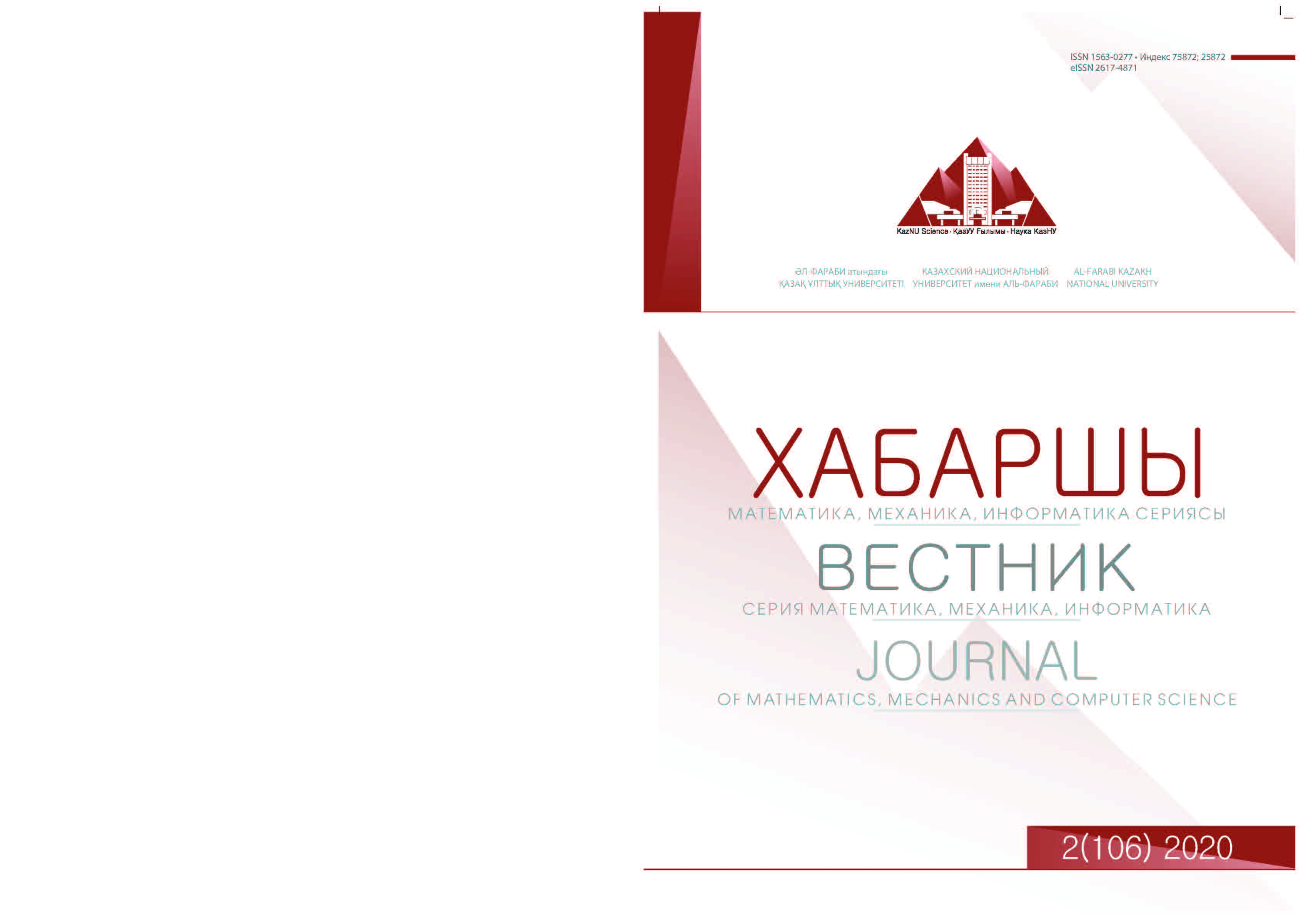Построение итерационного метода решения нелинейного уравнения эллиптического типа на основе смешанного метода конечных элементов
DOI:
https://doi.org/10.26577/JMMCS.2020.v106.i2.09Ключевые слова:
смешанный метод конечных элементов, нелинейное уравнение Пуассона, априорная оценка, итерационный метод, элементы Brezzi-Douglas-MariniАннотация
Данная статья посвящена построению и исследованию конечно-элементного
метода решения двумерного нелинейного уравнения эллиптического типа.
Уравнения данного типа возникают при решении многих прикладных задач,
включая задачи теории многофазной фильтрации, теории полупроводниковых
приборов и многих других. Актуальность исследования данной проблемы
связана с необходимостью разработки эффективных параллельных методов
решения указанной задачи. Для дискретизации уравнения используется смешанный
метод конечных элементов с элементами Brezzi-Douglas-Marini. Исследован
вопрос о сходимости конечно-элементного метода. Для линеаризации уравнения
построен итерационный метод Пикара. В работе использовано два класса
базисных функций конечных элементов. Проведен сравнительный анализ
эффективности нескольких прямых и итерационных методов решения полученной
системы линейных алгебраических уравнений, включая метод, основанный
на LDLt-факторизации Bunch-Kaufman, метод минимальных невязок, симметричный
LQ-метод, стабилизированный метод бисопряженных градиентов, и ряд
других итерационных алгоритмов подпространства Крылова с предобуславливателями
на основе неполного LU-разложения. Метод апробирован на нескольких
модельных задачах посредством сравнения приближенного решения задачи с известным
точным решением. Представлены результаты анализа погрешности метода
в различных нормах в зависимости от диаметра сетки.
Библиографические ссылки
[2] Atkinson K. and Hansen O. "Solving the Nonlinear Poisson Equation on the Unit Disk" , Journal of Integral Equations
no. 3 (2005): 223-251.
[3] Auricchio F., Veiga L., Brezzi F. and Lovadina C. "Mixed finite element methods" , Encyclopedia of Computational Mechanics Second Edition no.1 (2017): 1–53.
[4] Puscas M. A., Enchery G. and Desroziers, S. "Application of the mixed multiscale finite element method to parallel simulations of two-phase flows in porous media" , Oil and Gas Science and Technology vol. 73, no. 38 (2018): 1-14.
[5] Muzhinji K., Shateyi S. and Motsa S. "The Mixed Finite Element Multigrid Method for Stokes Equations" , The Scientific World Journal no. 460421 (2015): 1–12.
[6] Vorwerk J., Engwer C., Pursiainen S. and Wolters C. "A mixed finite element method to solve the EEG forward problem" ,
IEEE transations on medical imaging no. 4 (2016): 930–941.
[7] Spiridonov D., Huang J., Vasilyeva M., Huang Yu. and Chung, E. "Mixed generalized multiscale finite element method for Darcy-Forchheimer model" , Mathematics vol. 7, no. 1212 (2019): 1–13.
[8] Brown D. L. and Vasilyeva M. "Generalized multiscale finite element method for poroelasticity problems II: nonlinear coupling" , Journal of Computational and Applied Mathematics vol. 297 (2016): 132–146.
[9] Rebholz L., Viguerie A. and Xiao M. "Efficient nonlinear iteration schemes based on algebraic splitting for the incom- pressible Navier-Stokes equations" , Mathematics of Computation vol. 88, no. 318 (2019): 1533–1557.
[10] Islam M., Hye A. and Mamun A. "Nonlinear Effects on the Convergence of Picard and Newton Iteration Methods in the Numerical Solution of One-Dimensional Variably Saturated–Unsaturated Flow Problems" , Hydrology vol. 4, no. 50 (2017): 1–18.
[11] Kuraz M., Mayer P. and Pech P. "Solving the nonlinear Richards equation model with adaptive domain decomposition" ,
Journal of Computational and Applied Mathematics vol. 270 (2014): 2-11.
[12] Nakshatrala K. and Turner D. "A mixed formulation for a modification to Darcy equation based on Picard linearization and numerical solutions to large-scale realistic problems" , International Journal for Computational Methods in Engineering Science and Mechanics vol. 14, no. 6 (2013): 524–541.
[13] Madzvamuse A. and Chung A. "Fully implicit time-stepping schemes and non-linear solvers for systems of reaction– diffusion equations" , Applied Mathematics and Computation vol. 244 (2014): 361–374.
[14] Muccino J. and Luo H. "Picard iterations for a finite element shallow water equation model" , Ocean modeling vol. 10 (2005): 316–341.
[15] Zha Y., Yang J., Yin L., Zhang Y., Zheng, W. and Shi L. "A modified Picard iteration scheme for overcoming numerical difficulties of simulating infiltration into dry soil" , Journal of Hydrology vol. 551 (2017): 56–69.
[16] List F. and Radu F. "A study on iterative methods for solving Richards’ equation" , arXiv vol. 1507.07837v1 (2015): 1–16.
[17] Baboulin M., Dongarra J., Remy A., Tomov S. and Yamazaki I. "Solving dense symmetric indefinite systems using GPU" ,
Concurrency and Computation vol. 29, no. 9 (2017): 1–17.
[18] Zhong-Zhi B. "Motivations and realizations of Krylov subspace methods for large sparse linear systems" , Journal of Computational and Applied Mathematics vol. 283, no. 1 (2015): 71–78.
[19] Tran H., Toh K. and Phoon K. "Preconditioned IDR(s) iterative solver for non-symmetric linear system associated with FEM analysis of shallow foundation" , International Journal for Numerical and Analytical Methods in Geomechanics vol. 37 (2013): 2972–2986.
[20] Choi S., Paige C. and Saunders M. "MINRES-QLP: A Krylov subspace method for indefinite or singular symmetric systems" , SIAM Journal of Scientific Computing vol. 3, no. 4 (2011): 1810–1836.
[21] Chronopoulos A. T. and Kucherov A. "Block s-step Krylov iterative methods" , Numerical Linear Algebra with Applica- tions vol. 17, no. 1 (2010): 3–15.
[22] Cotter C. and Kirby R. "Mixed finite elements for global tide models" , Numerische Mathematik no. 133 (2015): 255–277.
[23] Chen Z. "Finite element methods and their applications"(Springer, 2007).
[24] Kozulik, V. and Gotovac, B. "Numerical solution of Poisson’s Equation in an arbitrary domain by using meshless R- function method" , Proceeding of the 27th DAAM International Symposium on Intellect Manufacturing and Automation (2016): 245–254.




